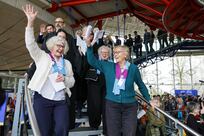ABU DHABI // Some of the UAE's neighbours are not prepared to cope with the expected surge in regional air traffic over the next decade, aviation experts warned yesterday. While the UAE already has advanced air-traffic control systems in place, allowing aeroplanes to fly closer together in safety, other countries in the region are lagging behind.
Without substantial investment, there is a risk that the expected rapid growth of flights in the region - with the UAE forecast to increase from 500,000 last year to 1.4 million in 2020 could lead to bottlenecks and an increased number of delays, experts added. Majdi Sabri, the vice president for the Middle East and North Africa region of the International Air Transport Association (IATA), said more advanced systems were needed throughout the Gulf region as its air traffic continues to expand.
"In this region, the infrastructure and air-traffic control procedures are not capable of managing growth," he said. "We have a very congested region, especially in the Gulf airspace. The UAE's main carriers, Emirates Airline and Etihad Airways, have hundreds of aircraft on order. How they and other carriers will all share the limited airspace has become a matter of urgent debate for aviation authorities, who met in the capital yesterday at the Air Traffic Control Middle East 2009 conference.
UAE authorities called on neighbouring countries to follow its lead. The country has introduced a navigation system, RNAV1, that shrinks the size of airspace corridors from 16km to 3.2km, allowing more corridors around airports. Meanwhile, new systems and processes allow the UAE to fly two aircraft as little as 18.5km apart, said Hassan Karam, the director of air navigation services for the General Civil Aviation Authority (GCAA), the federal body responsible for aviation.
The much bigger gap is required elsewhere in the region. In Kuwait, for instance, more than 100km must be left between two planes, Mr Karam said. "We have learned about how the UAE is getting state-of-the-art equipment," Mr Sabri said. "Cooperation on regional airspace is a big question I hope your conference will address." "We cannot work in isolation," said Sultan al Mansoori, the Minister of the Economy and chairman of the GCAA, adding "there is a need to create much better co-ordination between the region".
The UAE has so far signed agreements with Oman and Qatar that will see them use the same system, said Mr Karam. The GCAA has a meeting scheduled with Bahrain to discuss introducting the system there, too. "Expanding this area of RNAV1 is the ultimate solution to such a space as this," Mr Karam said. "You saw that in the Middle East region the growth rate is significant. We need to do something about utilising the capacity and unifying of the airways by introducing the RNAV1."
Saleem Hassan, Bahrain's head of civilian air -traffic management, said his country was planning to use the RNAV1 system. However, he said the kingdom was facing difficulties in managing air traffic owing to a lack of radar coverage. "We need to share radar to improve the area," he said, noting it has such an agreement with Kuwait. Bahrain favours a regional traffic-control system to coordinate the region's congested skies.
The GCAA opposes the idea because it says the region has not yet reached its maximum traffic capacity. Mr Sabri also stressed a need for better co-ordination between civil and military authorities. "Military restrictions also limit the expansion," he said. "There are lots of routes that are not really straight lines which make it expensive." In the UAE, an agreement reached with the Armed Forces last year allows previously restricted military airspace over the Empty Quarter to be used by commercial airliners.
mchung@thenational.ae





